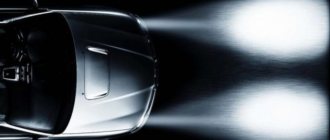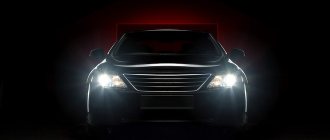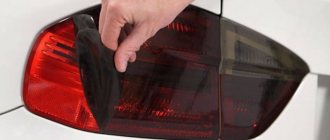Hello, dear readers. Today we will fully examine the topic of xenon on a car from the legal side. Let's look at the punishment for xenon, talk about what to do if you are stopped by an inspector with xenon and how to install truly legal xenon on any car.
The light emitted by xenon has characteristics similar to daylight, so the outlines of objects can be seen much more clearly. The visibility created by xenon in any weather conditions does not create unnecessary visual strain; rays of xenon light pass through drops of rain or fog and completely illuminate the road surface. The xenon light beam is much wider than usual, which, of course, improves the visibility of objects on the side of the road. Xenon emits twice as much light as a halogen lamp while consuming half the energy. The service life of xenon lamps is 2800-3000 hours. The service life of halogen lamps is 180-500 hours.
Gas-discharge xenon lamps began to be used in car headlights in 1992. They have greater light output and lower energy consumption than halogen and incandescent lamps. However, due to the design features of xenon lamps, they cannot be used in headlights designed to install traditional types of lamps. Simply replacing a halogen lamp with a xenon lamp leads, first of all, to dazzling oncoming and passing drivers, which is certainly a threat to road safety. Therefore, the current legislation of the Russian Federation provides for administrative liability for the use of external lighting devices that do not meet the requirements and design of the vehicle.
To begin with, let us turn to the clarifications on the use of “Xenon” headlights provided by the Road Safety Department of the Ministry of Internal Affairs of the Russian Federation dated February 20, 2010.
Currently, the following officially approved types of headlights are installed on vehicles:
– C – low beam, R – high beam, CR – dual-mode (low and high beam) light with incandescent lamps (UNECE Rules No. 112, GOST R 41.112-2005); – HC – low beam, HR – high beam, HCR – dual-mode light with halogen incandescent lamps (UNECE Rules N 112, GOST R 41.112-2005); – DC – low beam, DR – high beam, DCR – dual-mode light with gas-discharge light sources (UNECE Rules N 98, GOST R 41.98-99).
Explanations of the Ministry of Internal Affairs of the Russian Federation dated February 20, 2010
The approval mark is depicted in the form of a circle with the letter “E” inside, followed by the number of the country that granted the approval, as well as the number of the approval itself. Such a sign, together with the corresponding headlamp marking, is applied to the headlamp lens or to its housing if the lens can be separated.
The category of halogen incandescent lamps has a designation on their base or bulb that begins with the letter “H”.
Gas-discharge light sources (including xenon) , the category marking of which, indicated on the base, begins with the letter “D” , in accordance with the requirements of UNECE Regulation No. 99
and
GOST R 41.99-99 “Uniform regulations concerning the official approval of gas-discharge light sources for use in officially approved gas-discharge optical elements of motor vehicles”
are intended for use only in headlights of types
DC, DR, DCR.
Based on clarifications from the Federal State Unitary Enterprise “Research and Experimental Institute of Automotive Electronics and Electrical Equipment” (NIIAE)
the use of light sources in external lighting devices that do not correspond to the type of the given lighting device violates the conditions for ensuring road safety due to a number of physical (dimensions of the spark discharge, wavelength, scattering angle of reflected radiation) and technical (class of the reflective surface of the reflector, presence on the vehicle automatic light beam corrector and headlight washer) factors.
Thus, the use of gas-discharge light sources in headlights intended for use with incandescent lamps, including halogen ones, should be qualified as a discrepancy in the operating mode of external lighting devices (a set of technical characteristics of headlights corresponding to a particular light distribution that ensures road safety depending on road situation and weather conditions) to the requirements of the vehicle design.
Responsibility
In answer to this question, I would like to note the following: it just so happens in Russia that the burden of proving guilt no longer lies with traffic police officers in the event of going to court to resolve a controversial situation. From now on, it is you who will have to prove your innocence; the courts, as a rule, have little understanding of all the intricacies of this issue and in most cases take the side of the traffic police officers.
So, what is the fine for xenon in 2021? And are they deprived of their rights for xenon? Illegally installed xenon is a malfunction in which the operation of the vehicle is prohibited.
Light fixtures do not have lenses or use lenses and lamps that do not match the type of light fixture.
Clause 3.4 of Chapter 3 of the List of faults
Driving a car with unauthorized xenon lamps installed in headlights not intended for their installation entails deprivation of the right to drive a car for a period of six months to a year with confiscation of these lamps and devices for their operation (Part 3 of Article 12.5 of the Code of Administrative Offenses of the Russian Federation). Just like that, but there is no fine - you immediately lose your license for xenon.
Driving a vehicle on the front of which are installed lighting devices with red lights or red reflective devices, as well as lighting devices, the color of the lights and the mode of operation of which do not comply with the requirements of the Basic Regulations for the admission of vehicles to operation and the duties of safety officials road traffic (as amended by Federal Law No. 210-FZ of July 24, 2007) entails deprivation of the right to drive vehicles for a period of six months to one year with confiscation of the specified devices and accessories. (Part 3 introduced by Federal Law dated July 22, 2005 N 120-FZ)
Part 3 of Article 12.5 of the Code of Administrative Offenses of the Russian Federation
Devices for operating xenon lamps are devices designed to ensure their functionality (ignition units and other equipment directly servicing the operation of xenon lamps).
general characteristics
There are a wide variety of headlight lighting products on the market today. The classic option is considered to be for cars H4 with white light. This type of base has been produced for a long time, so manufacturers have perfected this design as much as possible.
The presented type of lamps has two spirals. One of them provides high beam, and the second - low beam. Today, car owners can purchase LED and xenon lamps in addition to halogen ones. However, due to certain reasons (high price, the need to purchase additional equipment), these varieties have not yet become so widespread.
Halogen lamps are in demand today. They differ in a number of characteristics. Such devices are installed in the headlights of cars of various brands. The products of Osram and Bosch were recognized as being of the highest quality. There are other options that may be inferior to the presented manufacturers in some respects.
Installing LED headlights: different options
From a legislative point of view, the installation of diode headlights will make a fundamental difference in the following cases:
- Factory installed LED headlights. Certification of lighting equipment is carried out by the manufacturer himself; the buyer does not need to worry about anything.
- Installation of LED headlights that are standardly installed on the vehicle by the manufacturer. Re-registration with the traffic police will be required; approval of the installation is not required.
- Installation of LED headlights when the manufacturer did not provide for this type of headlights. Installation approval and re-registration with the traffic police will be required.
Let's consider the last two options, since the first does not require additional explanation.
Installing LED bulbs in halogen headlights
Let's say you are the owner of a regular car with halogen optics, and you want to install LED lamps instead of halogen ones. Let's consider this situation from the point of view of traffic regulations. As you know, car headlights are always made for a specific type of lamp, and are marked accordingly. For example, if you install a xenon lamp in a headlight designed for halogen lamps, we will get a significant “flare” around the edges - the reflector is designed for an almost point source of light at the desired point, while the xenon lamp is a cylinder filled with luminous gas. Therefore, precise focusing of the light flux does not occur, and such headlights will always blind oncoming drivers and everyone around.
So is it possible to install LED bulbs in halogen headlights?
No, since this leads to the implementation of paragraph 3.1 of the Appendix to the Traffic Regulations “List of faults and conditions under which the operation of vehicles is prohibited”
List of faults, clause 3.1. The number, type, color, location and operating mode of external lighting devices do not meet the requirements of the vehicle design.
The punishment for this violation is provided for in Part 1 of Article 12.5 of the Code of Administrative Offenses:
Code of Administrative Offenses of the Russian Federation, Art. 12.5 h 1 . Driving a vehicle in the presence of malfunctions or conditions under which, in accordance with the Basic Provisions for the admission of vehicles to operation and the duties of officials to ensure road safety, operation of the vehicle is prohibited, with the exception of malfunctions and conditions specified in parts 2 - 7 of this article , - entails a warning or the imposition of an administrative fine in the amount of five hundred rubles.
Thus, the maximum fine for installing LED light bulbs is 500 rubles. How will an inspector check the type of headlights on a car? It’s very simple - according to the factory markings on the headlight glass. We talked more about headlight markings in the article Are xenon lamps allowed?
Is it possible to install LED headlights instead of halogen ones?
If we talk about replacing entire headlights with ones designed for LED lamps, then such a conversion is usually possible. We are talking about the re-equipment of a car, which is carried out in accordance with the Technical Regulations of the Customs Union “On the Safety of Wheeled Vehicles”:
75. Verification of compliance with the requirements for vehicles in operation in the event of changes to their design is carried out in the form of a preliminary technical examination of the design for the possibility of making changes and subsequent verification of the safety of the design and technical inspection of the vehicle with changes made to the design . During the preliminary technical examination, it is ensured that after changes are made to the design of the vehicle, its compliance with the requirements of these technical regulations that were in force at the time the vehicle was put into circulation will remain. During the safety check of the vehicle design, it is ensured that after changes are made to the design of the vehicle, its safety meets the requirements of these technical regulations.
Cracks, fire and blindness: what happens if you put the wrong bulbs in your headlights?
We will conditionally divide our material into two sections. In the first part we will condemn, castigate and anathematize attempts to modernize standard headlights, and in the second we will examine several funny problems caused by car light bulbs.
Why and for what
It is clear that all Kulibin’s ideas are caused by the desire to make the light of halogen headlights brighter. To do this, you can either change something in the standard light, or install a non-standard one. Let's start with the first one.
The global mind of the automotive community has given birth to two main concepts for modernizing standard lights. The first comes down to installing more powerful light bulbs, the second – to raising the voltage in the headlights. In both cases, something often goes wrong. Yes, these methods can make the headlights shine better, but at the same time they have a bunch of side effects, compared to which using morphine for painkillers will seem like applying plantain to a bruise.
So, is it possible to replace 55-watt bulbs with 60-watt bulbs? Can. But this won’t do any good: for the light to become noticeably better, you need not “sixties”, but at least 90-100 watts. It will really shine brighter, but not for long. Let's remember the school physics course.
There is a law called the Joule-Lenz law (Joule and Lenz are two different guys). The formulation of the law states that the power of heat released per unit volume of a medium when a direct electric current flows is equal to the product of the electric current density and the electric field strength. We can reformulate: the amount of heat released per unit time in the section of the circuit under consideration is proportional to the product of the square of the current in this section and the resistance of the section. In the form of a formula in this case, the law looks like this:
Q=I2Rt,
where Q is the amount of heat, I is the current strength, and Rt is the resistance of the section.
Obviously, the higher the resistance, the more heat will be generated. This means that the wiring will heat up. And strongly. In addition, the lamp itself generates more heat. And this leads to many undesirable consequences. Firstly, the reflector burns out, and the plastic one melts very well.
And secondly, in many cars (especially older ones), power current passes through the light switch. There are no relays that would be controlled by a lever on the steering wheel or a knob on the panel, and all current goes directly through this switch. Any switch implies the presence of a contact group, in which there are areas of high resistance (especially if the contacts are oxidized). According to the formula Q=I2Rt, at an equal current there will be more heat in sections of the circuit with increased resistance. Therefore, the contacts begin to burn in the literal sense of the word. At best, they simply melt. And the light switch goes into the trash, because there is often simply nothing to repair in a burnt-out “dragonfly” (“guitar” or whatever they are called).
For the same reason, the connectors in the wiring suffer. They are usually plastic and also melt wonderfully. And when they actively melt, you can reach a short circuit. It’s good if the fuses are not Chinese, they will save the wiring. Well, theoretically, the consequences could be very serious.
To avoid failure of the light switch, unloading relays are often installed. In this case, the switch only controls the operation of the relay, and no power current passes through it. The method is good and it really helps. But it only saves the switch itself, and not the headlights and their connectors. There, of course, the current remains the same, which means hello to melted reflectors, bases and wires.
And one last thing: a powerful lamp heats up the headlight lens very much. It is clear that plastic can also melt, but with glass it is a different story. It is designed for a certain temperature, but it is impossible to melt it with a light bulb. Glass dies according to its own scenario: if you overheat it and then splash water from a puddle, then it will crack.
It turns out that installing a more powerful lamp will bring more trouble than light. Maybe the second way - with increasing voltage - will give a more interesting result?
Theoretically, yes. Even a small increase in voltage of 5% makes the light bulb glow almost 20% brighter. This seems wonderful, but you won’t be able to grab free cheese here either: such an increase in luminous flux reduces the life of the lamp by almost half. Is it worth it? Probably not.
In addition, there is another question: how can you increase the voltage in a car? Theoretically, one diode soldered into the voltage regulator circuit is enough for this. There are other methods, but they will all increase the voltage in the entire on-board network. You can strain and increase the voltage only on sections of the head light circuit. But this is already a degree of stubbornness that makes no sense to consider.
I think we have given enough arguments in favor of the fact that neither more powerful lamps nor changing the voltage on them will give a normal result. Here we need a different approach: install lamps of a different type. For example, LED.
Not just fines
Another path that some comrades take is installing LED lamps instead of halogen ones. Does this make sense? Yes, sometimes there is, but let’s digress from technical issues for a second and see what the traffic police think about this.
And they think badly about it. If you install an LED lamp in a regular halogen headlight, you will get a classic violation of paragraph 3.1 of the list of faults and conditions under which the operation of vehicles is prohibited - the number, type, color, location and operating mode of external lighting devices do not meet the requirements of the vehicle design. Previously, people were simply deprived of the right to drive for this, but since 2021 the situation has changed. Now the resolution of the Plenum of the Supreme Court of the Russian Federation No. 20 is in force. The text there is long and tedious, but it all boils down to the fact that if the color of LED bulbs does not differ from the color of factory halogen bulbs, then you can get off with a fine of 500 rubles. Additionally, there are ways to legitimize remodeling. True, not always. But let’s not get distracted by legal lessons - all these legal somersaults are secondary. Let's get back to technology.
So, LED lamps are capable of shining better than halogen lamps, and this is a fact. Therefore, sometimes installing them makes sense. But here, too, mistakes are often made that nullify the entire beneficial effect. First of all, due to the wrong choice of light bulb.
If you pick up a regular halogen lamp with an H4 base, you can see two filaments in it - low beam and high beam. These threads are not located next to each other, but at different distances from the base. And the headlight reflector is designed in such a way that it focuses the light from both spirals in different ways, according to the location of the spirals in the lamp bulb. But in the cheapest LED lamps, the LEDs are located “back to back” at the same distance from the base (this way the cost of the lamp is lower). A headlight with such a lamp is more likely to burst from the strain than to focus the low and high beam in the correct way. Therefore, the entire effect of the LEDs will be covered by a blurry beam directed into space, bushes, and the eyes of oncoming drivers. In a word, directed anywhere except the road.
Although it should be noted that in good LED lamps the placement of the LEDs corresponds to the placement of the filaments of halogen lamps. And such lamps shine really well. The main thing is not to forget about what I said just above: traffic police officers do not like such light. Although, purely theoretically, they do not have the right to disassemble the headlight and see what the lamp costs. But still.
Small troubles and big questions
Now let's move on to the second part of the question: what can you do wrong with light bulbs unintentionally? Not in the process of “improving”, and not by accident?
Of course, people often make mistakes with the color of the lamps. Moreover, the mistake is strange - conscious. They say that white lamps with a color temperature of more than 4000-4200 K are beautiful and bright, which means you can see the road better. But this is not so: white light is scattered very strongly in water droplets, so nothing can be seen in the fog with such lamps. And it’s also very difficult to see in snowfall and just a wet road. So what’s beautiful is not always right. I think everyone knows this fact, so let's move on.
Oddly enough, many people complain that after replacing the light bulb in the headlight, the adjustment is lost, the corrector does not help, and the headlights do not shine at all. Hypothetically, a new lamp can throw off the adjustment of the light beam, but to do this you need to manage to put a very bad lamp in place of a bad one. With other lamps there are no differences in the position of the filaments, so if you replace one good lamp with another, the headlight adjustment will not be lost. But the light is still getting worse. Why?
For a simple reason, which may even seem funny: sometimes light bulbs manage to be placed upside down. In the headlights of some cars this is possible, and the inverted bulb fits in so well that no suspicion arises: it went in and snapped into place as expected.
An inverted low beam bulb works very poorly: there is a small screen above the low beam filament, which cuts off the upper part of the light beam and directs the light onto the road. If the lamp is turned upside down, the low beam begins to shine into the sky and into oncoming cars, but not onto the road. It's funny, but it happens. For example, on the first generation Citroen C4, where it is difficult to get the lamp out of habit, but it is easy to stick it in upside down.
In general, there are no other mistakes when installing lamps. If you do not touch the halogen lamp with your bare hands and work carefully, then everything will be fine. But lamps are not only found in headlights.
A funny problem occurs with double-filament lamps for side lights and brake lights. They are not used on all cars (many have two separate lamps), but for those that have them (from VAZ 2115 to Fords), a situation may arise when you really want to go to a professional electrician for service. It all looks like this: when you press the brake pedal, the lights and interior lights turn on by themselves (the instrument panel lights up and everything else that should light up when the lights are on). Many people immediately start looking for the “short” in the wiring, but in reality everything is simpler: the burnt-out brake light thread successfully closes the clearance thread, and when you press the brake, voltage is supplied to the clearance circuit. In this case, it is enough to simply replace the double-filament lamp. Although in some cases, either the wiring or a shorted burnt cartridge is really to blame for these miracles.
Another panic attack is associated with brake lights, which sometimes affects, for example, owners of some Nissans (Note, Almera Classic, X-Trail). The car suddenly stops picking up speed and kick-down refuses to work. The point is again in the “stoppers”: as soon as they both stop working, the ECU turns on an emergency mode that prohibits a sharp increase in speed. At the same time, for example, the X-Trail T30 instruction manual talks about this, but for some reason the T31 manual was silent. By the way, not only Nissan has such a “feature”, so you need to keep an eye on the brake lights. Some cars, when the brake lights are not lit, do not limit the opening of the throttle valve, but, for example, turn off the ABS and display a corresponding error. Or they don’t go at all (usually “Japanese” for the domestic market).
Exactly the same set of errors can be obtained when replacing conventional lamps in brake lights with LEDs. They consume little current, and the ECU believes that the stoppers simply do not work.
In general, it should be noted that intervention in optics rarely brings good results. You can get a fire, loss of license, curses from blinded oncoming drivers, but noticeably positive results are unlikely. At this point, you either change the car, or endure it and monitor the condition of the stock light. And sometimes it’s enough just to polish the headlight lenses.
And finally, it’s worth noting that those who tint their taillights should be ashamed. And here it’s even pointless to tell why.
When can LED headlights be installed?
If LED headlights are installed on a car by the manufacturer, then installation of such headlights can be carried out according to a simplified scheme. No examination will be required to determine whether such a conversion is possible in principle. It will be enough to make a replacement in a workshop certified for such work and register the conversion with the traffic police. This is evidenced by paragraph 77 of section 4 of chapter V of the technical regulations of the customs union:
77. Vehicles are not subject to inspection in the following cases: 1) when installing components on a vehicle: intended for this vehicle and having passed the conformity assessment as part of this vehicle, which is confirmed by the documentation of the component manufacturer; provided by the vehicle manufacturer in the operational documentation; 2) when serial changes are made to the design on the basis of design documentation developed and approved in the prescribed manner, if on its basis an assessment of the conformity of the changes made was carried out.
That is, the checks specified in clause 75 of the Customs Regulations will not be required in this case.
Is the crossing allowed for fishing?
There was a serious uproar around the article Catching catfish with a line. The popularity is incredible.











